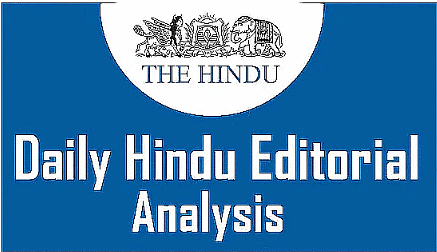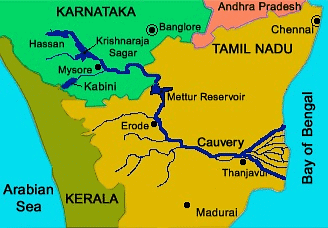UPSC Exam > UPSC Notes > Current Affairs & Hindu Analysis: Daily, Weekly & Monthly > The Hindu Editorial Analysis- 20th September 2023
The Hindu Editorial Analysis- 20th September 2023 | Current Affairs & Hindu Analysis: Daily, Weekly & Monthly - UPSC PDF Download

The Cauvery Water Management Authority should act
Why in News?
What Led to Tamil Nadu's Appeal to the Supreme Court?
- Tamil Nadu's Appeal to SC:
- The issue arose from Karnataka's refusal to abide by previously agreed-upon water release quantities.
- Tamil Nadu advocates for the release of 10,000 cusecs of water for the stipulated 15-day duration. On the other hand, Karnataka has suggested a reduced water release of 8,000 cusecs for the same 15-day timeframe.
- Karnataka's Explanation:
- Karnataka cites poor inflow due to reduced rainfall in Cauvery catchment, including origin point Kodagu.
- Karnataka highlights a 44% rainfall deficit in Kodagu from June to August.
- Karnataka rejects Tamil Nadu's distress-sharing formula demand.
- Implications:
- Tamil Nadu's farmers await Karnataka's response, as the Mettur reservoir holds only 20 TMC, lasting ten days.
- The Supreme Court's decision holds significance in resolving the complex dispute.
- Collaborative solutions are crucial for equitable water management and conflict resolution.
How is the Cauvery Water Being Shared?
- A carefully crafted monthly schedule governs the distribution of water between Karnataka and Tamil Nadu, the two riparian states of the Cauvery basin.
- In a "normal" water year, Karnataka is bound to release 177.25 TMC (thousand million cubic feet) of water from June to May to Tamil Nadu.
- This annual quota includes 123.14 TMC allocated during the monsoon months from June to September.
- The ongoing southwest monsoon season often triggers disputes when rainfall falls short of expectations.
What is the Cauvery River Dispute?
- River Cauvery (Kaveri):
- It is known as ‘Ponni’ in Tamil and is a sacred river of southern India.
- It rises on Brahmagiri Hill of the Western Ghats in southwestern Karnataka state, flows in a southeasterly direction through the states of Karnataka and Tamil Nadu, and descends the Eastern Ghats in a series of great falls and drains into Bay of Bengal through Pondicherry.
- Left Bank Tributary: Arkavathi, Hemavathi, Shimsa, and Harangi.
- Right Bank Tributary: Lakshmantirtha, Suvarnavati, Noyil, Bhavani, Kabini, and Amaravathi.

- The Dispute:
- As the river originates in Karnataka, flows through Tamil Nadu with major tributaries coming from Kerala and drains into the Bay of Bengal through Pondicherry the dispute therefore involves 3 states and one Union Territory.
- The genesis of the dispute is 150 years old and dates back to the two agreements of arbitration in 1892 and 1924 between the then Madras presidency and Mysore.
- It entailed the principle that the upper riparian state must obtain consent of lower riparian state for any construction activity viz. reservoir on the river Cauvery.
- The Cauvery water dispute between Karnataka and Tamil Nadu began in 1974 when Karnataka started diverting water without Tamil Nadu's consent.
- After several years, the Cauvery Water Disputes Tribunal (CWDT) was established in 1990 to resolve the issue. It took 17 years for the CWDT to reach a final order in 2007, which outlined the sharing of Cauvery water among the four riparian states. In distress years, water would be shared on a pro-rata basis.
- CWDT issued its final award in February 2007, specifying water allocations among the four states in the Cauvery basin, considering the total availability of 740 TMC in a normal year.
- The allocation of water among the four states is as follows: Tamil Nadu - 404.25 TMC, Karnataka - 284.75 TMC, Kerala - 30 TMC, and Puducherry - 7 TMC.
- In 2018, the Supreme Court declared the Cauvery a national asset and largely upheld the water-sharing arrangements determined by the CWDT.
- It also directed the Centre to notify the Cauvery Management Scheme.
- The central government notified the ‘Cauvery Water Management Scheme’ in June 2018, constituting the ‘Cauvery Water Management Authority’ and the ‘Cauvery Water Regulation Committee’.
The document The Hindu Editorial Analysis- 20th September 2023 | Current Affairs & Hindu Analysis: Daily, Weekly & Monthly - UPSC is a part of the UPSC Course Current Affairs & Hindu Analysis: Daily, Weekly & Monthly.
All you need of UPSC at this link: UPSC
|
38 videos|5288 docs|1117 tests
|
Related Searches
















